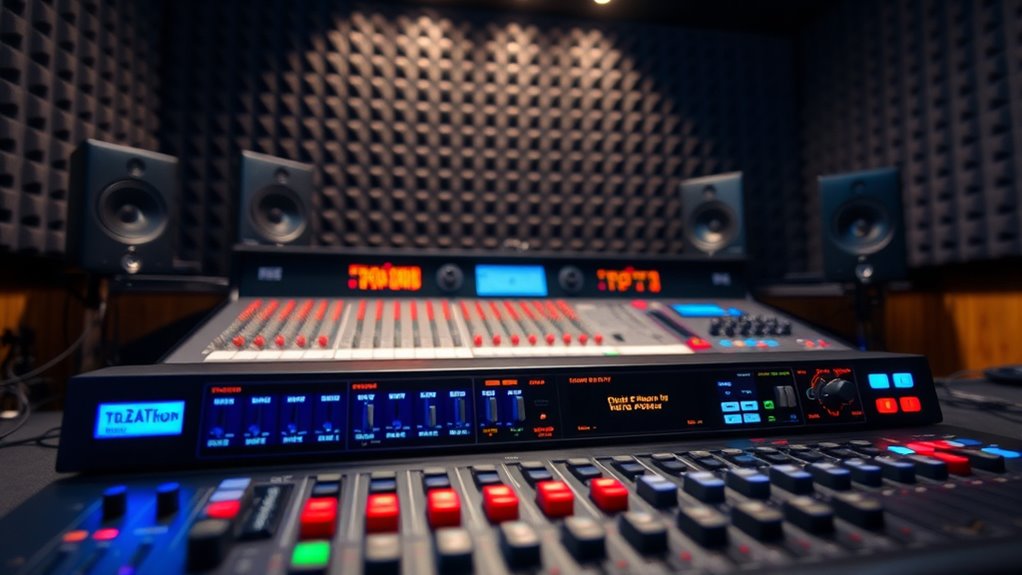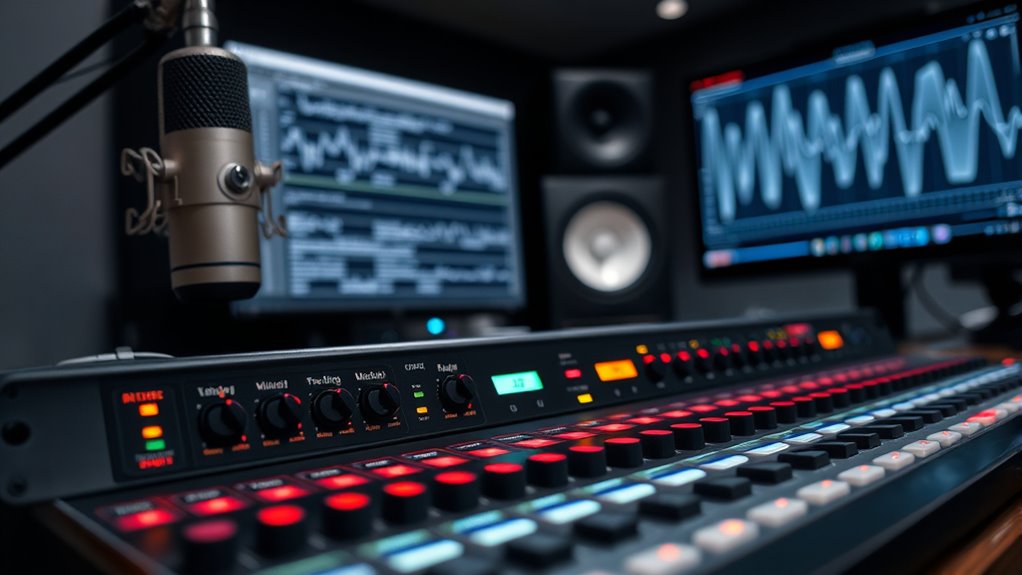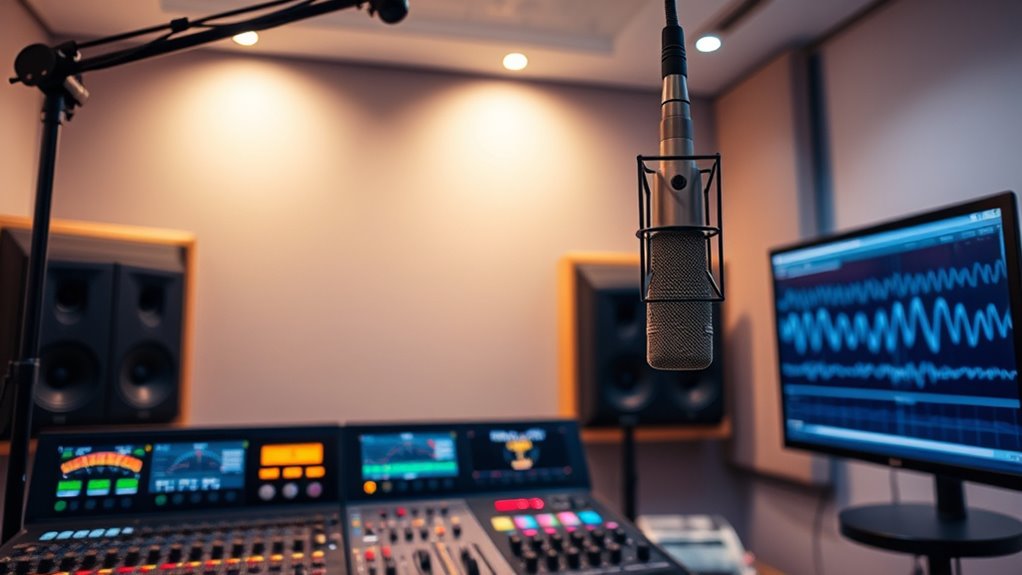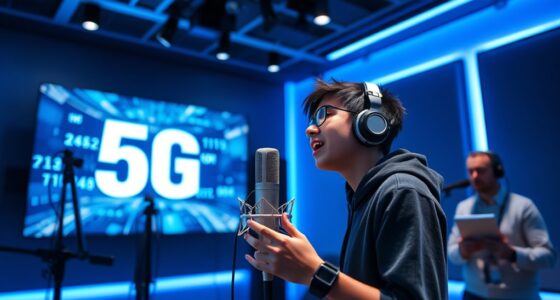Using 32-bit float for voiceover recording can offer extra headroom and flexibility, especially with unpredictable loud sounds or complex projects. However, for most VO work, it’s overkill since 24-bit or even 16-bit often provide enough quality and dynamic range. If you’re concerned about clipping or want maximum editing freedom, 32-bit float can help—but understanding your specific needs will guarantee you avoid unnecessary complexity. Want to see if it’s right for you?
Key Takeaways
- 32-bit float offers extensive dynamic range, preventing clipping in unpredictable or loud voiceover recordings.
- It simplifies post-production editing by allowing gain adjustments without quality loss.
- For controlled VO sessions with consistent volume, 24-bit or lower bit depths are typically sufficient.
- The larger file sizes and processing demands of 32-bit float may outweigh benefits for standard voice recordings.
- Use 32-bit float mainly when recording in environments with high dynamic variability or unpredictable loud sounds.
Understanding Bit Depth in Audio Recording

Understanding bit depth in audio recording is essential because it determines how accurately your sound is captured and reproduced. Many bit depth myths circulate, leading people to believe that higher bit depths always mean better quality. In reality, bit depth affects your audio resolution, specifically how finely it can represent volume levels. For example, increasing bit depth from 16-bit to 24-bit provides a greater dynamic range, capturing subtler nuances in your recordings. However, beyond a certain point, higher bit depths may not considerably improve your sound quality for most applications. Recognizing how bit depth impacts audio resolution helps you make informed decisions about your recording settings. Additionally, understanding dynamic range and how it relates to bit depth can help you optimize your recordings for different environments. Don’t fall for myths that suggest more bits always mean better sound—understanding the true role of bit depth ensures you optimize your audio quality effectively.
What Is 32‑Bit Float and How Does It Work?

A 32-bit float is a digital audio format that stores sound data using floating-point representation, allowing for a much wider dynamic range and greater precision than traditional fixed-point formats like 16-bit or 24-bit. Unlike fixed-point formats, where bit depth directly determines the maximum audio fidelity, 32-bit float uses an exponent and mantissa to encode audio signals. This structure enables you to capture and process a broader range of sound levels without clipping or losing detail. The key advantage is that it preserves audio fidelity even when levels vary markedly during recording or editing. Because of its extensive bit depth, 32-bit float offers exceptional flexibility for handling complex audio signals, making it ideal for scenarios where maintaining high quality is critical. Additionally, it facilitates audio processing without introducing artifacts, which is especially beneficial during intensive editing workflows.
Advantages of Using 32‑Bit Float for Voiceovers

Using 32-bit float for voiceovers offers significant benefits by ensuring the highest possible audio quality throughout your recording and editing process. It provides a wide dynamic range, reducing the risk of clipping and distortion, even with unexpected volume spikes. Additionally, it simplifies audio compression, as there’s less need to normalize levels during editing. You’ll also enjoy more flexibility when adjusting gain or reverb without quality loss. While file storage might increase, the advantages outweigh the drawbacks for professional results.
- Minimized audio compression artifacts for cleaner sound
- Greater editing latitude without quality compromise
- Easier to handle unexpected volume changes
- Improved overall fidelity for polished voiceovers
- Understanding the various recording formats can help optimize your workflow and ensure compatibility with editing software.
Common Recording Standards: 16‑Bit and 24‑Bit Explained

Common recording standards like 16-bit and 24-bit define how audio signals are digitized and stored, directly affecting sound quality and editing flexibility. Many bit depth myths suggest higher resolution always equals better sound, but understanding recording resolution helps clarify this. 16-bit offers a dynamic range suitable for most applications, while 24-bit provides more headroom for editing and noise reduction. The choice between these standards depends on your recording needs; 16-bit is typically enough for finished projects, whereas 24-bit gives more room during capture and editing. Recognizing the differences in bit depth helps you avoid misconceptions and select appropriate resolution for your voiceover work, ensuring clarity without overcomplicating your workflow.
Practical Benefits of Higher Bit Depths in VO Work

Higher bit depths help preserve the full dynamic range of your voice recordings, allowing you to capture both quiet whispers and loud exclamations without distortion. They also reduce quantization noise, resulting in cleaner, more natural sound quality. These benefits can make a noticeable difference in post-production flexibility and overall clarity. Additionally, eco-friendly recording practices can minimize environmental impact by using energy-efficient hardware and sustainable materials.
Dynamic Range Preservation
Because voice-over recordings often capture subtle dynamic variations, higher bit depths help preserve this range without introducing noise or distortion. This is vital for maintaining audio fidelity, especially when you want your recordings to sound natural and professional. Many people have bit depth misconceptions, assuming 16-bit is always enough, but higher bit depths prevent clipping and preserve quiet details. With increased bit depth, you get:
- Better handling of soft and loud sounds
- Reduced risk of digital distortion
- More accurate dynamic representation
- Easier editing and processing without quality loss
This means you can record with confidence, knowing your audio retains its nuance. Higher bit depths ensure your voice-over captures the full spectrum of your performance, making it more engaging and true to life.
Reduced Quantization Noise
Using a higher bit depth substantially reduces quantization noise, which is the digital distortion that occurs when the audio signal is rounded to the nearest available value. This rounding creates quantization error, leading to subtle but noticeable distortion in your recordings. With increased bit depth, each sample has more possible levels, minimizing this error and preserving audio fidelity. As a result, your voice recordings sound clearer and more natural, especially during quiet passages or subtle nuances. Lower bit depths introduce more quantization noise, which can mask quiet details and reduce overall clarity. By choosing a higher bit depth like 32-bit float, you effectively decrease quantization noise, ensuring your VO recordings maintain their quality even after editing or processing.
Potential Drawbacks of 32‑Bit Float Recording

- Larger file sizes that demand more storage space
- Increased processing power, potentially slowing workflows
- Compatibility issues with older hardware or software
- Overkill for simple voice recordings, making the extra data redundant
- Crochet styles for locs can be more effectively showcased with appropriate audio quality, but 32-bit float may be unnecessary for such applications.
Hardware and Software Compatibility Considerations

When considering 32-bit float recording, it’s important to evaluate whether your current hardware and software can support this format. Hardware limitations, such as your audio interface’s bit depth and processing power, might restrict compatibility. Older devices or those designed primarily for 16- or 24-bit recording may struggle with 32-bit float files. Similarly, software compatibility is fundamental; not all digital audio workstations (DAWs) or plugins can handle 32-bit float files seamlessly. You need to confirm that your recording software supports this format and that it can import, process, and export 32-bit float recordings without issues. Upgrading hardware or updating software might be necessary to fully leverage the benefits of 32-bit float, ensuring smooth workflow and accurate audio handling. Additionally, understanding the AI security implications related to data handling can help ensure your recordings remain secure during processing and storage.
When Is 32‑Bit Float Actually Necessary?

You’ll find 32-bit float recording most useful when dealing with recordings that have a wide dynamic range or unpredictable peaks. It helps prevent clipping if loud sounds suddenly occur, giving you more flexibility in post-production. If your recordings often push the limits of your hardware’s input, 32-bit float can be a real advantage. Additionally, understanding expert advice can help you decide when such advanced recording settings are truly necessary.
Handling Dynamic Range
Handling dynamic range becomes essential when recording sources with unpredictable or extreme volume variations, as traditional 24-bit audio can sometimes fall short. When your source has loud peaks or quiet passages, a higher bit depth guarantees you capture all details without distortion. 32-bit float recordings provide an extended dynamic range, reducing the risk of clipping or noise.
Consider these points:
- Complex vocal performances with sudden volume shifts
- Multiple sound sources with varying loudness levels
- Environments with unpredictable noise or echo
- Long recordings where gain adjustments might be needed later
If your project involves these scenarios, 32-bit float can be invaluable. It’s especially useful when precise control over dynamic range matters, making it a smart choice for high-quality VO recordings.
Managing Audio Clipping
Managing audio clipping becomes critical in situations where sudden loud sounds threaten to distort your recording. To prevent this, proper microphone placement is essential; position the mic to minimize capturing unexpected peaks. Using effective audio compression during recording helps tame loud transients, reducing the risk of clipping. However, even with compression, peaks can still overload your system if levels are too high. This is where 32-bit float recording shines, as it provides extra headroom and preserves audio quality without immediate clipping. If you’re working in environments prone to unpredictable loud sounds, investing in 32-bit float can save you from re-recording. But for most controlled VO sessions, careful microphone placement combined with real-time audio compression often suffices to manage clipping effectively.
Making the Right Choice for Your Voiceover Projects

Choosing the right bit depth for your voiceover projects depends on your specific needs and the quality you aim to achieve. Higher bit depths improve audio fidelity by capturing more detail, but they also increase file size and processing demands. Consider these factors when making your choice:
- Project scope: Is this for a professional demo or casual use?
- Editing flexibility: Do you need extensive post-processing?
- Storage capacity: Do you have enough space for larger files?
- Final delivery format: Will it be compressed or kept lossless?
Selecting the appropriate bit depth ensures your recordings meet your quality standards without unnecessary overhead. Balancing audio fidelity with practical constraints helps you produce clear, professional voiceovers that suit your project’s goals. Additionally, understanding audio quality standards can guide you in making the most informed decision for your recordings.
Frequently Asked Questions
How Does 32-Bit Float Impact File Storage Size?
A 32-bit float substantially impacts file storage size because of its higher bit depth, which allows for greater dynamic range and precision. While it offers excellent audio quality, it results in larger files compared to lower bit depths. File compression can help reduce these sizes, but the increased bit depth still means you’ll need more storage space. You’ll want to weigh the benefits of quality against storage limitations when choosing 32-bit float.
Can 32-Bit Float Improve Editing Flexibility in Post-Production?
You’re about to discover a game-changer—32‑bit float dramatically boosts your editing flexibility. It unlocks an enormous dynamic range, making it easier to fix harsh peaks or lows without quality loss. This precision lets you fine-tune your voice recordings with ease, ensuring professional results even if initial levels aren’t perfect. So yes, 32‑bit float isn’t just overkill; it’s a powerful tool for achieving pristine, polished voiceovers.
Is 32-Bit Float Compatible With All Digital Audio Workstations?
You might wonder if 32-bit float is compatible with your digital audio workstation. Most modern DAWs support 32-bit float, ensuring high bit depth and audio fidelity. This format preserves audio quality during editing and mixing, giving you more flexibility. Before recording, check your DAW’s specifications to confirm compatibility, but generally, using 32-bit float enhances your audio workflow without risking compatibility issues.
Does 32-Bit Float Increase Processing Load During Recording?
Think of bit depth as the size of a container holding your sound. Using 32-bit float adds more capacity, but it does bring a processing overhead—like fueling a larger engine. During recording, this increased load can strain your system, especially if it’s not robust. While it offers more dynamic range, consider if your setup can handle the extra processing, so your workflow stays smooth and efficient.
Are There Specific Voiceover Scenarios That Benefit Most From 32-Bit Float?
You’ll find that certain voiceover scenarios benefit most from 32-bit float recording, especially those with a wide dynamic range or unpredictable noise floor. If your project involves capturing subtle nuances or loud bursts without distortion, 32-bit float preserves audio quality better than standard formats. It’s ideal when you need maximum flexibility in post-production, ensuring you can adjust levels without introducing noise or losing detail in quiet moments.
Conclusion
Choosing between 16‑bit, 24‑bit, or 32‑bit float is like tuning an instrument—you want the right sound without overcomplicating. For most voiceover projects, lower bit depths deliver clean, professional results. 32‑bit float can feel like overkill, adding complexity without real benefit. Focus on your needs and setup, and you’ll find the perfect balance—like a song that hits just right, not too loud or soft.









